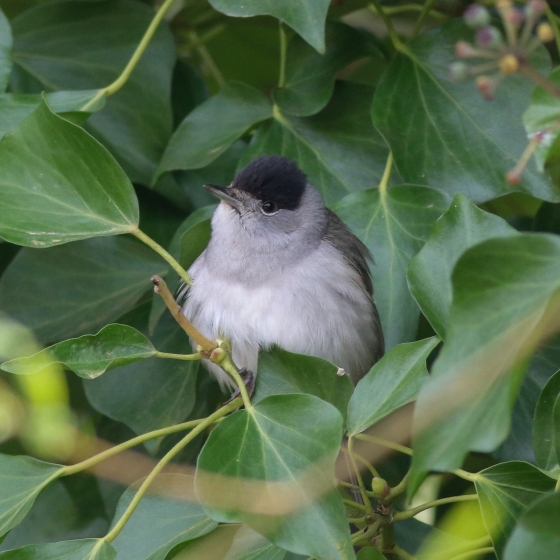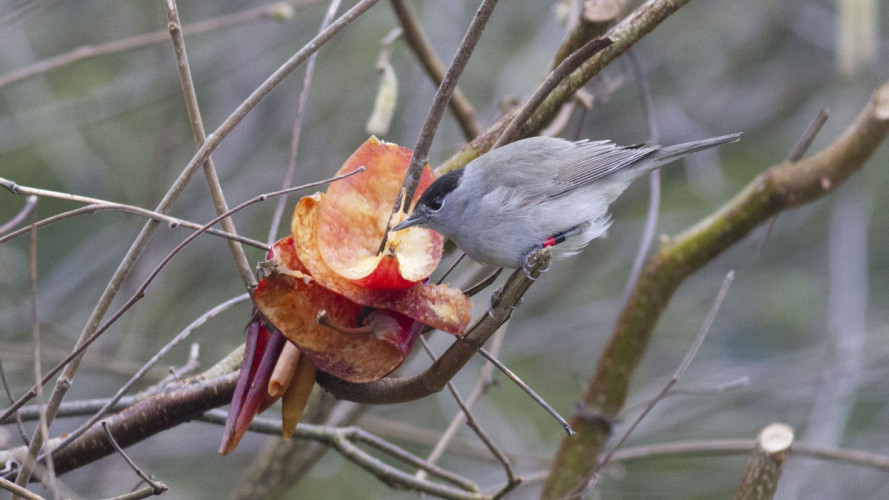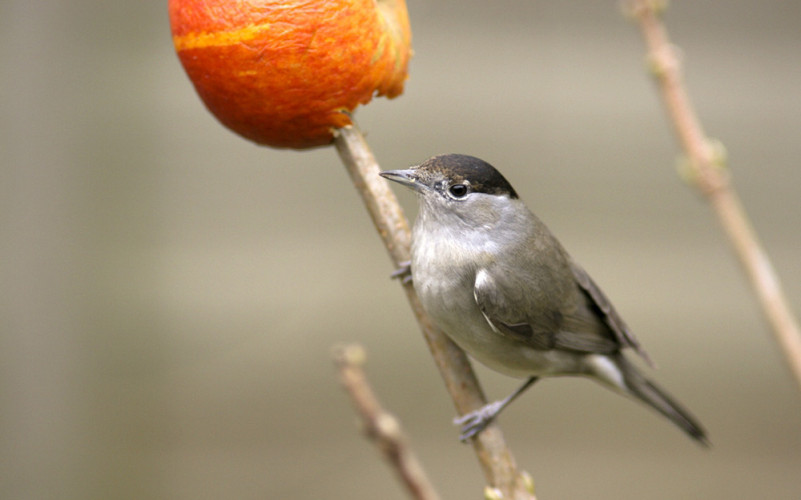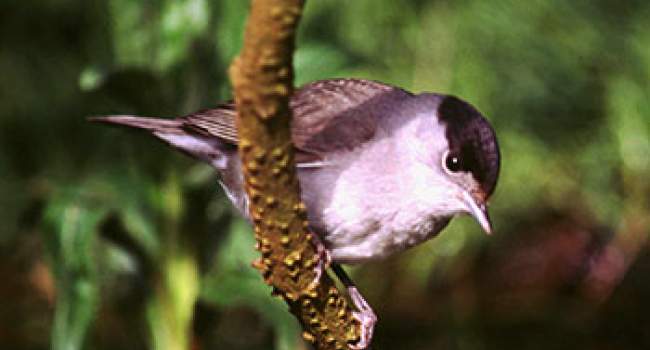Blackcap
Sylvia atricapilla (Linnaeus, 1758)
BC
 BLACA
BLACA  12770
12770

Family: Passeriformes > Sylviidae

This melodic warbler is widely distributed across Britain & Ireland through the breeding season, and increasingly in winter too.
Blackcap breeding numbers have steadily increased in the UK since the late-1970s, and have also expanded their breeding range throughout northern Scotland and the island of Ireland during this time. They are now absent only on the highest Scottish peaks and farthest flung islands.
In autumn, these breeding birds depart for southern Europe and are replaced by Blackcaps from central Europe. BTO research has helped show how garden bird feeding led to the evolution of this new migratory route and wintering strategy. Although widespread in winter, Blackcaps tend to be absent from the uplands at this time of year.
Blackcaps have a greyish overall appearance. The eponymous black cap is only found in the males; females and juveniles have a brown cap instead. The song is very similar to that of the Garden Warbler, but can be distinguished with practice. Blackcaps are found in parks, deciduous woodland and scrub, as well as at garden feeding stations.
Exploring the trends for Blackcap
Our Trends Explorer will also give you the latest insight into how the UK's Blackcap population is changing.
trends explorerIdentification
Blackcap identification is often straightforward. The following article may help when identifying Blackcap.
SONGS AND CALLS
Listen to example recordings of the main vocalisations of Blackcap, provided by xeno-canto contributors.
Call
Song
Develop your bird ID skills with our training courses
Our interactive online courses are a great way to develop your bird identification skills, whether you're new to the hobby or a competent birder looking to hone your abilities.
Browse training coursesStatus and Trends
Population size and trends and patterns of distribution based on BTO surveys and atlases with data collected by BTO volunteers.
CONSERVATION STATUS
This species can be found on the following statutory and conservation listings and schedules.
POPULATION CHANGE
Blackcap abundance in the UK has increased consistently since the late 1970s, a trend common to all habitats and evident from both the CBC/BBS and the CES indices. An extraordinary acceleration of the upward trend occurred from 2008 to 2013. Overall increase has occurred despite a reduction in habitat quality for Blackcap, and other species dependent on the understorey, brought about by deer browsing in young woodland (Holt et al. 2012d). The BBS map of change in relative density between 1994-96 and 2007-09 indicates that increase occurred widely throughout the UK range over that period. An even more rapid increase in Northern Ireland and in Scotland, where much new ground has been colonised (Balmer et al. 2013), is indicated by the most recent BBS trends. There has been an increase across Europe since 1980 (PECBMS: PECBMS 2020a>).
| UK breeding population |
+363% increase (1967–2022) 
|
Exploring the trends for Blackcap
Our Trends Explorer will also give you the latest insight into how the UK's Blackcap population is changing.
trends explorerDISTRIBUTION
Breeding Blackcaps are widely distributed throughout Britain and Ireland, with highest densities in lowland areas in southern Britain and in pockets throughout Ireland. Wintering numbers have increased steeply since the 1990s, with numbers peaking in gardens in late January or February.
Occupied 10-km squares in UK
| No. occupied in breeding season | 2578 |
| % occupied in breeding season | 85 |
| No. occupied in winter | 1516 |
| % occupied in winter | 50 |
European Distribution Map
European Breeding Bird Atlas 2
Breeding Season Habitats
| Most frequent in |
Deciduous Wood 
|
| Also common in | Scrub |
Relative frequency by habitat
Relative occurrence in different habitat types during the breeding season.

DISTRIBUTION CHANGE
There have been extensive gains in the Blackcap's breeding range since the 1968–72 Breeding Atlas; the range has expanded in Ireland by a staggering 241%, and in Britain by 51%, with most of the British gains being in Scotland.
Change in occupied 10-km squares in the UK
| % change in range in breeding season (1968–72 to 2008–11) | +29.5% |
| % change in range in winter (1981–84 to 2007–11) | +56.4% |
SEASONALITY
Blackcap is a scarce winter visitor and common summer visitor, with a rapid arrival of birds in April when Blackcap song can be heard in many wooded habitats.

Movement
Information about movement and migration based on online bird portals (e.g. BirdTrack), Ringing schemes and tracking studies.
An overview of year-round movements for the whole of Europe can be seen on the EuroBirdPortal viewer.
RINGING RECOVERIES
View a summary of recoveries in the Online Ringing Report.
Foreign locations of birds ringed or recovered in Britain & Ireland

Biology
Lifecycle and body size information about Blackcap, including statistics on nesting, eggs and lifespan based on BTO ringing and nest recording data.
PRODUCTIVITY & NESTING
Exploring the trends for Blackcap
Our Trends Explorer will also give you the latest insight into how the UK's Blackcap population is changing.
trends explorerSURVIVAL & LONGEVITY
View number ringed each year in the Online Ringing Report
Exploring the trends for Blackcap
Our Trends Explorer will also give you the latest insight into how the UK's Blackcap population is changing.
trends explorerBIOMETRICS
Wing Length 
|
Adults | 74.8±2 | Range 72–78mm, N=24217 |
| Juveniles | 74.6±2.1 | Range 72-77mm, N=52901 | |
| Males | 74.8±2 | Range 72–78mm, N=13613 | |
| Females | 74.8±2 | Range 72–78mm, N=10514 |
Body Weight 
|
Adults | 17.7±2 | Range 15.4–21.0g, N=21657 |
| Juveniles | 18.9±2.1 | Range 16.0–22.7g, N=48922 | |
| Males | 17.4±2.2 | Range 15.3–20.3g, N=12124 | |
| Females | 18.1±1.8 | Range 15.6–21.5g, N=9454 |
Feather measurements and photos on featherbase 
CODES & CLASSIFICATION
Ring size 
|
A (pulli B) |
Field Codes 
|
2-letter: BC | 5-letter code: BLACA | Euring: 12770 |
For information in another language (where available) click on a linked name
Research
Interpretation and scientific publications about Blackcap from BTO scientists.
CAUSES AND SOLUTIONS
Causes of change
The causes of the increase in this species remain unknown.
Further information on causes of change
According to CES, productivity has fluctuated markedly, obscuring any long-term trend in CES or NRS data. Survival rates have been stable. Using data from France, Julliard (2004) found that population growth rate was under the additive influence of survival and recruitment.
Analysis of phenological data has found that this species advanced its arrival date in the UK, between the 1960s and 2000s, by 18 days ( Newson et al. 2016). This is in line with the trend towards earlier laying, amounting to an advance of almost two weeks since 1968, which may be a response to recent climate change (Crick & Sparks 1999, Croxton et al. 2006). The more rapid increase in Scotland indicated by BBS suggests that climatic warming may be allowing this species to extend its range northwards (Hewson et al. 2007).
Information about conservation actions
The population of this species has increased consistently since the 1970s, hence it is not a species of concern and no conservation actions are currently required.
Conservation actions benefiting other woodland species may also help Blackcap further, particularly those which enhance understorey vegetation and in particular the scrub layer, for example the control of deer numbers to reduce grazing.
PUBLICATIONS (2)

Human activity shapes the wintering ecology of a migratory bird
Feeding garden birds changes Blackcap migration patterns
New research using data from BTO's Ringing Scheme and Garden BirdWatch shows how we are shaping the natural world through actions in our own back gardens.

Is supplementary feeding in gardens a driver of evolutionary change in a migratory bird species?
Garden bird feeding and a changing climate are driving evolutionary change in Blackcaps
New research using data from Garden BirdWatch has revealed that bird food provided in British gardens has helped Blackcaps to rapidly evolve a successful new migration route. This is the first time that garden bird feeding has been shown to affect large-scale bird distributions.
Links to more studies from ConservationEvidence.com
- Effects of the Arable Stewardship Pilot Scheme on breeding birds at field and farm-scales
- Conserving the Seychelles warbler Acrocephalus sechellensis by translocation: a transfer from Cousin Island to Aride Island
- Translocation of the Seychelles warbler Acrocephalus sechellensis to establish a new population on Denis Island, Seychelles
Would you like to search for another species?














Share this page